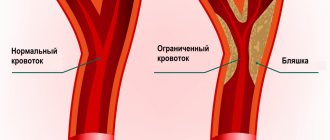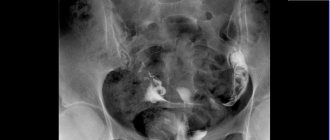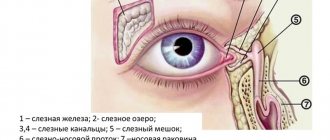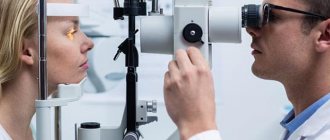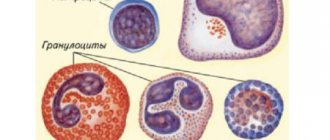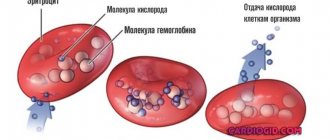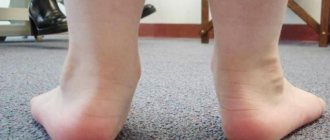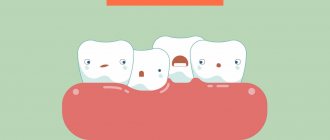If you've recently watched a crying baby or the latest sentimental Hollywood movie, you're well aware that tears run down your face.
However, we also have a tear duct (also called the "nasolacrimal duct" and "tear duct"). through which tears pass through the nose. These drainage tubes cause a runny nose when crying or an allergic reaction in the eyes.
When the tear duct becomes blocked, problems arise. Let's look at the causes of blocked tear ducts, how it happens and how to get rid of it.
Symptoms of the disease
Manifestations of dacryocystitis in newborns are externally similar to the signs of another purulent eye disease - conjunctivitis:
- In the second week of the baby's life, purulent discharge from the eyes appears.
- Pus is released from the lacrimal openings if you press lightly on the area where the lacrimal sac is located.
- The conjunctiva and skin at the inner corner of the eye turns red.
- The eyelids swell and swell.
- Tears flow from the eyes even when the child is not crying.
- When the baby wakes up, his eyelashes are stuck together.
- Such manifestations can occur in both eyes at once, or in one.
Symptoms of blocked tear ducts
Blocked tear ducts or an infection caused by the blockage can present with a number of symptoms. This includes:
- Watery eyes and excessive tearing
- Repeated inflammation and infections (infections may be caused by the blockage or lead to the blockage)
- Buildup or secretion of mucus
- Pain and swelling in the corners of the eyes
- Blurred vision
- Bloody tears
Your ophthalmologist will be able to evaluate the function of the tear duct drainage and determine treatment options.
Causes of dacryocystitis in newborns
| 1. Lacrimal canaliculus (8 mm) 2. Ampoule (2 mm) 3. Lacrimal sac 4. Nasolacrimal canal (12 mm) 5. Orifices of the nasal canal |
Obstruction of the nasolacrimal ducts in a child develops if, after the birth of the baby, the special thin membrane that protected the eyes from the penetration of amniotic fluid during intrauterine development does not rupture. The unnecessary film interferes with the normal outflow of tear fluid, it stagnates, infection occurs - as a result, purulent inflammation of the lacrimal sac is formed (dacryocystitis).
Causes of lacrimal duct obstruction
Obstruction of the lacrimal ducts can occur for various reasons, the main ones being:
- congenital obstruction that occurs due to underdevelopment of the drainage system or blockage of the passage by a mucus plug (as a rule, such a defect goes away on its own in the first months after the birth of the child);
- developmental defects of the face and skull;
- narrowing of the tear ducts due to aging of the body;
- inflammatory processes of the eyes, nose and tear ducts, which, in particular, are caused by chronic infections;
- facial injuries resulting in damage to bone structures in the area of the lacrimal canals;
- formation of stones and cysts in the drainage system of the organs of vision;
- tumors of bones, lacrimal sac and a number of other structures;
- taking certain medications.
In addition, it is worth noting that the risk of tear duct obstruction increases in the presence of factors such as:
- chronic eye inflammation (for example, conjunctivitis);
- previous operations on the eyes, eyelids and sinuses;
- undergone courses of chemotherapy or radiation treatment;
- glaucoma (in this case, the use of antiglaucoma drugs can lead to obstruction of the lacrimal ducts).
How is dacryocystitis in newborns treated?
In some cases, the problem resolves on its own by the end of the second week. But sometimes a protective film remains on the eyes - and here the help of a pediatric ophthalmologist is required. It is important to carry out treatment in a timely manner so as not to provoke a serious complication - phlegmon of the lacrimal sac, which can lead to the formation of fistulas.
For treatment, massage of the lacrimal canal may be prescribed. The doctor teaches the parents the technique, and then they perform the massage themselves, at home. Special massage movements are designed to increase pressure in the nasal ducts, causing the embryonic membrane to rupture. The massage is performed every day four to seven times. And in the second or third month of the child’s life, the obstruction disappears.
The massage is complemented by the use of drops that relieve inflammation.
Principles of treatment
Treatment depends on the form of the disease and the severity of clinical manifestations. Newborn babies are most often prescribed massage of the lacrimal sac, with the help of which it is possible to get rid of the mucus plug and restore the normal outflow of tears. If the expected effect does not occur after a month, it is recommended to carry out probing. This technique is used mainly in the first six months of life, before teething.
If the child has an acquired form of the pathology, treatment begins immediately with rinsing the nasolacrimal duct.
If there is no therapeutic effect from probing, dacryocystorhinostomy is performed. During the operation, specialists create an artificial passage between the nasal cavity and the lacrimal sac. With the help of intubation stands it is possible to prevent relapse of the pathology in the future. Making an appointment Today: 27 registered
What if massage didn't help?
When the appointment of a massage does not give the desired effect by the age of two or three months, additional diagnostics are required. Based on its results, probing of the nasolacrimal duct may be prescribed, and in some cases, repeated probing of the nasolacrimal duct.
The doctor at our clinic first explains to parents how probing of the nasolacrimal duct is done for children. This is a minor surgical procedure that is performed under local anesthesia and takes five to ten minutes.
- The doctor puts painkilling drops into the child's eyes.
- Then a special instrument, the Sichel probe, is inserted into the lacrimal ducts. This allows the lacrimal openings and nasolacrimal ducts to expand.
- A longer Bowman probe is then used and lowered to the required depth to break the no longer needed film.
- At the end of the operation, the canal is washed and disinfected.
As practice shows, up to the age of eight months, this procedure is 99% effective. If nasolacrimal duct obstruction persists in children, repeat probing of the nasolacrimal duct in newborns may be performed.
If your doctor suggests that you undergo such a procedure, you should listen to the recommendations, since obstruction can lead to serious consequences.
Sounding is carried out at the Optic Center clinic at 40 Let Oktyabrya, 15/1. or you can make an appointment with the clinic administrators by phone, or by calling the toll-free number 8-800-775-78-58
Sign up for a comprehensive examination
The structure of the lacrimal gland
The gland that synthesizes tear fluid consists of two parts: lower (palpebral, orbital) and upper (orbital, secular). These parts are separated by a muscular tendon responsible for raising the upper eyelid.
The orbital part is located in the upper outer region of the orbit. 3-5 excretory tubules emerge from it, flowing into the upper fornix of the conjunctiva. The palpebral part (its smaller size) is localized slightly lower, above the conjunctiva. The excretory ducts open into the ducts of the orbital part or into the conjunctival sac.
The blood supply to the glands is carried out by the ophthalmic artery, and innervation by the trigeminal and facial nerves, as well as fibers of the cervical plexus. Nerve impulses enter the lacrimal center located in the medulla oblongata.
How to properly massage the nasolacrimal duct in a newborn baby:
- First, mom needs to wash her hands! The newborn’s body is still very weak, since it has not acquired its own immunity, having become accustomed to hiding behind the mother’s protection inside the womb. Therefore, any infection is easily caught by the baby and transformed into a new disease.
- Mom's nails should be cut short!!!!
- Use a cotton pad to remove all discharge and crusts that have formed after sleep.
- Also, before the massage, it is necessary to toilet the nose. To do this, you need to drip drops based on sea water into both nasal passages, then remove all the boogers using cotton wool. Only now, when the eyes and nose are clean, can the massage begin.
- It is done by softly touching the pad of the index finger in the direction from the inner corner of the eye, located near the nose, moving strictly from top to bottom. The movements should be jerky, but the finger should not slide over the baby’s skin, it should remain in place! Pressure is created inside, which breaks through the embryonic film. 6-10 up and down movements are enough. Attention! You need to massage the tear ducts strictly, from top to bottom!!!
- This massage should be done at least 5-6 times a day for at least two weeks, before feeding. It is best to start massage when the baby is crying. At this moment, the tubules are tense, so the breakthrough of the film will be painless. But the older the child gets, the more painful the film is torn. After 3-7 days, the film will resolve or break through, and there will be no consequences from dacryocystitis.
After the massage, and not instead of it, you need to instill drops with disinfectant properties (those prescribed by the doctor!). Instill without touching the tip of the pipette/tube to your eyelids and face, this will keep the drops sterile!!! If the massage does not have a positive effect within 14 days, then you need to see an ophthalmologist to decide on further treatment. The earlier treatment is started, the higher the effectiveness and the sooner the cure.
Diagnostics
The initial examination is carried out by a therapist. An ophthalmologist diagnoses such diseases.
In adults
First, the symptoms of the disease are determined and the patient’s medical history is examined. To make an accurate diagnosis, he conducts laboratory tests:
- Instills collargol solution into the eyes to determine the source of inflammation.
- Takes a sample of the lacrimal canal to determine the degree of obstruction.
- Conducts a culture of pus that comes out during palpation - identifying an infectious disease.
- Prescribes eye x-rays - if the cause of obstruction is mechanical damage.
Important!
The main thing is to determine what kind of disease has affected the patient’s eyes - dacryocystitis or conjunctivitis. These are different pathologies caused by different pathogens.
In children
Diagnosis of blockage of the nasolacrimal duct in newborns is carried out on the basis of the mother’s story about the child’s well-being. Carry out:
- ophthalmological examination;
- tubular test;
- bacteriological examination;
- endoscopic examination of the nasal cavity;
- general blood and urine analysis.
Additionally, parents and their child visit related doctors:
- ENT;
- Pediatrician.
This measure is necessary in order to exclude concomitant diseases.
Dacryocystitis in adults
Often this eye pathology occurs in middle-aged and elderly people, and women are diagnosed seven times more often than men. Unlike children, in whom the disease is usually congenital, in adults dacryocystitis occurs for a number of reasons:
- viral or bacterial eye pathologies that contribute to the development of edema that compresses the tear ducts;
- chronic inflammation of the tear ducts - dacryoadenitis;
- violation of the integrity of the tear ducts due to injuries;
- ingress of particles of cosmetic products due to untimely removal of makeup;
- polyps in the nasal cavity;
- consequences of severe bleeding - blood clots form and increased secretion of exudate begins, which can contribute to the formation of dacryolites.
Symptoms of dacryocystitis in adults and diagnosis
In general, the manifestations of the disease in both children and adults are similar. The area of the lacrimal sac becomes noticeably red and swollen, and after some time purulent discharge begins from the eyes, as the nasolacrimal duct becomes clogged. When pressing on the inflamed area, a person experiences pain.
If the disease occurs in an acute form, the pain can be very sensitive. The tumor becomes denser, and after a few days it begins to soften and the swelling subsides. At this time, an abscess is formed, which can spontaneously open, and due to the outflow of pus from it, the swelling will decrease.
To diagnose dacryocystitis in adults, the doctor prescribes a general analysis of urine and blood, and a smear for bacterial culture. Rhinoscopy is required, which is necessary to exclude diseases associated with abnormalities in the structure of the nose. A canalicular test may also be prescribed, during which a Collargol dye solution is instilled into the patient’s eyes. After this, they look to see if the solution goes into the tubules. If this does not happen, then this is a clear sign of blockage of the ducts.
Rules for massage
For a massage to be effective, it must be done according to the following rules:
- Movements should be fast, but not strong. There is no need to put pressure on your eyes.
- A single movement takes about five seconds.
- Stimulation should end with a crunch – a breakthrough of the membrane membrane. It is this breakthrough that releases pus from the canal and clears the way for tears.
Attention!
It is necessary to remember the rules of personal hygiene. Never reach into your eyes with dirty hands - this will only make the situation worse.
If you self-medicate for a long time and do not visit an ophthalmologist, you can end up with severe eye complications, including loss of vision. Therefore, the first and most important rule is to begin treatment only after examination by an ophthalmologist.
Analysis of results
Best materials of the month
- Coronaviruses: SARS-CoV-2 (COVID-19)
- Antibiotics for the prevention and treatment of COVID-19: how effective are they?
- The most common "office" diseases
- Does vodka kill coronavirus?
- How to stay alive on our roads?
Ophthalmologists interpret the results when washing the nasolacrimal canals according to the following scheme.
In the absence of pathology of the canals, the liquid easily flows through the nose. When introducing the solution, no particular effort is required; the liquid is injected with light pressure on the piston. Stenosis of the nasolacrimal duct or fusion of the canal orifices is indicated by the leakage of fluid from the opposite lacrimal punctum.
With stenosis of the nasolacrimal duct, fluid may begin to flow from the opposite lacrimal opening not immediately, but after a matter of seconds or after increasing pressure on the piston. At the same time, there are traces of blood in it. With stenosis of the internal part of the canal, fluid flows out from the same place where it was injected.
When the nasolacrimal duct becomes clogged, fluid flows out of the nose when the pressure on the syringe plunger increases.
Consequences of advanced dacryocystitis
A careless attitude towards this eye pathology, or the use of arbitrarily chosen folk methods of treatment can lead to negative consequences for eye health. Here are the complications that can result from advanced dacryocystitis:
- sepsis of tissues as a result of pus entering them;
- thrombosis of the cavernous sinus;
- thrombophlebitis of the veins of the orbital region;
- phlegmon of the orbit of the eye;
- inflammation of the membranes and tissues of the brain
- corneal ulcer, the appearance of a cataract.
The listed possible consequences are very serious, and even loss of vision in such cases is considered a favorable prognosis, since in most cases advanced dacryocystitis is fatal. Doctors warn that if you experience any discomfort, let alone externally noticeable inflammation in the eye area, you should immediately see a specialist who will make an accurate diagnosis and prescribe competent treatment.
MagazinLinz.ru team
